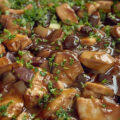For over 3,000 years, Jordan almonds, the iconic, pastel confectionery delight, have been cherished by people around the world for their delicate crunch and sugary sweetness. While these colorful candies are now commonly associated with weddings, showers, and special celebrations, their origins can be traced back to ancient times, with ties to Jewish history.
Jordan almonds are like the candy version of breaking a glass under the chuppah, or wedding canopy. Both are often seen at Jewish weddings (particularly sephardi weddings), a reminder of the duality of life. Even in our most ecstatic moments, we remember our own exile and what we’ve lost with the shattering of a glass. Conversely, bitter almonds, like bitter experiences, can be covered with sweetness until they resemble nothing of their former selves. (Food analogy #1)
Making food analogies represent life– very Jewish.
Almonds symbolize many things, including hope, renewal, and new beginnings. The Hebrew word for almond, shaked, means “to watch”. This connection is found in Jeremiah 1:11-12, where the prophet sees an almond branch in a vision, and God interprets it as a symbol of His watchful eye over His word.
Food analogy #2: Thus, almonds have become synonymous with God's vigilant care.
In the Song of Solomon (Shir HaShirim), almonds are mentioned twice, underscoring their significance. In Song of Solomon 6:11, the bride describes the beauty of her beloved’s life: “I went down into the garden of nuts to see the fruits of the valley, and to see whether the vine flourished, and the pomegranates budded.”
Food analogy #3: Here, the “garden of nuts” refers to an almond grove, and the verse is often associated with fertility and blessings.
Ok so we knew that Jews have a lot to say about almonds, but did Jordan almonds actually originate from Jordan?
Well yes, and no.
Over time, these delightful confections became an essential part of weddings and other joyous occasions, spreading from the Middle East to Europe and beyond. In the Encyclopedia of Jewish Foods author Gil Marks explains that when ancient trade routes brought sugar to the Middle East, cooks discovered how to caramelize the crystals and experimented with throwing chopped nuts into the mixture.
These candies continued westward overtime, eventually reaching Spain, France, and Italy.
The term, “Jordan almonds”, is said to have originated in France, of all places.
In France, confectioners named them “dragees Jordan ', defining them as sugar coated almonds that they believed to have originated in Jordan.
While Judaism has a lot to say about almonds, it seems the custom to present Jordan almonds during special occasions was adopted from the larger communities we resided within throughout millenia. During the Middle Ages, Jews began wrapping the confections (usually 5) into a piece of fabric and giving them as wedding favors to symbolize five blessings: health, wealth, happiness, fertility, and longevity.
5 Jordan almonds– 5 is an indivisible number, just as marriage should be healthy and therefore indivisible. Jordan almonds are often present at the henna ceremony common in some Sephardi circles to celebrate the engagement of a new couple.
Turkish Jews also have another interesting prenatal custom using sugared almonds. While Ashkenazi circles often keep news of pregnancy private amongst the family, Turkish Jews celebrate the coming birth of a first child with a ceremony called kortadura de fashadura (in Judeo-Spanish) or tekti’ a el-g’daouere (in Judeo-Arabic), meaning “the cutting of the swaddling clothes.”
When a Jewish woman reaches the fifth month of her first pregnancy, family and friends join together for the ceremonial cutting of a cloth made for the baby’s first outfit. A female relative who is both a mother herself and whose parents are still living (considered a good omen for long life) is honored with making the first cut in the outfit. At the exact moment of the cut, the pregnant woman throws white sugared almonds on the cloth, to symbolize the sweet and prosperous life for the unborn child.
Jordan almonds, with their rich history and cultural symbolism, continue to bring joy and sweetness to celebrations around the world. From their ancient roots in the Middle East to their significance in Jewish tradition, these sugary delights have truly stood the test of time.
As we savor these colorful confections, let us also cherish the stories and customs that have accompanied them throughout the ages, celebrating the enduring spirit of hope, renewal, and new beginnings that almonds have come to represent in Jewish history.

















I love almonds! This story is quite interesting. Thank you for sharing the history of the Jordan almond.
Thank you for this informative article. My Mother loved Jordan Almonds and I know at every shower and wedding; those almonds were there. After reading this great clip, I thought of my Mom. Thank you again.
I grew up on an almond orchard in California. There are many varieties of almonds which was good for production as the bees would cross pollinate between varieties. I'm sure there is a lesson there. In any event this is great timing as the almond harvest is just starting here in California. Here is hoping for a great almond harvest and to each of you a joyous life as we near the Jewish New Year.
Amen to that.
That must have been interesting -almond orchards.Must have been very beautiful too!! I have always loved almonds, maybe everyone does.Did your family own the orchard??